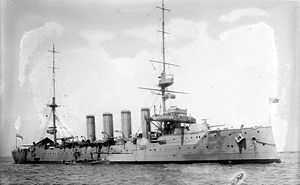Devonshire-class cruiser (1903)
 HMS Antrim | |
| Class overview | |
|---|---|
| Name: | Devonshire |
| Operators: |
|
| Preceded by: | Monmouth class |
| Succeeded by: | Duke of Edinburgh class |
| Built: | 1902–1905 |
| In commission: | 1905–1922 |
| Completed: | 6 |
| Lost: | 2 |
| Scrapped: | 4 |
| General characteristics | |
| Type: | Armoured cruiser |
| Displacement: | 10,850 long tons (11,020 t) (normal) |
| Length: | 473 ft 6 in (144.3 m) (o/a) |
| Beam: | 68 ft 6 in (20.9 m) |
| Draught: | 24 ft (7.3 m) |
| Installed power: | 21,000 ihp (16,000 kW) 17 Yarrow boilers; 6 cylindrical boilers |
| Propulsion: | 2 × Shafts 2 × 4-cylinder triple-expansion steam engines |
| Speed: | 22 knots (41 km/h; 25 mph) |
| Complement: | 610 |
| Armament: |
|
| Armour: | |
The Devonshire class was a class of six armoured cruisers of the British Royal Navy, launched in 1903–1904 at a cost of around £850,000 each.
The ships were designed for commerce protection, and the design was similar to the Monmouth class except that the twin 6 inch (152 mm) turrets and the forward double casemates were replaced by four 7.5 inch (190 mm) single turrets in a diamond arrangement. The 7.5 inch gun was introduced because the all – 6 inch gun armament of the Monmouth class was no longer adequate to deal with the latest likely commerce raiding threats.
All ships of the class served in World War I. Argyll was wrecked, and Hampshire was sunk by a naval mine. The four survivors were disposed of soon after the end of the war.
Ships
- Antrim, launched on 8 October 1903, sold for breaking up on 19 December 1922.
- Argyll, launched on 3 March 1904, wrecked on 28 October 1915.
- Carnarvon, launched on 7 October 1903, sold for breaking up on 8 November 1921.
- Devonshire, launched on 30 April 1904, sold for breaking up on 9 May 1921.
- Hampshire, launched on 4 September 1903, sunk by a naval mine on 5 June 1916.
- Roxburgh, launched on 19 January 1904, sold on 8 November 1921.
Building Programme
The following table gives the build details and purchase cost of the members of the Devonshire class. Standard British practice at that time was for these costs to exclude armament and stores. The 1905 edition costs were compiled before the ships were complete.
| Ship | Builder | Engine Maker |
Date of | Cost according to | |||
|---|---|---|---|---|---|---|---|
| Laid Down | Launch | Completion | (BNA 1905)[1] | (BNA 1906)[2] | |||
| Devonshire | Chatham Dockyard | Thames Ironworks | 25 Mar 1902 | 30 Apr 1904 | 24 Aug 1905 | £900,792 *** | £818,167 |
| Antrim | John Brown, Clydebank | John Brown | 27 Aug 1902 | 8 Oct 1903 | 23 Jun 1905 | £899,050 *** | £873,625 |
| Argyll | Scott, Greenock | Greenock Foundry | 1 Sep 1902 | 3 Mar 1904 | December 1905 | £912,588 *** | £873,598 |
| Carnarvon | Beardmore | Humphrys | 1 Oct 1902 | 17 Oct 1903 | 29 May 1905 | £899,465 *** | £858,130 |
| Hampshire | Armstrong, Elswick | Hawthorn | 1 Sep 1902 | 24 Sep 1903 | 15 Jul 1905 | £872,327 *** | £833,817 |
| Roxburgh | London & Glasgow Shipping Company |
London & Glasgow Shipping Company |
13 Jun 1902 | 9 Jan 1904 | 5 Sep 1905 | £866,199 *** | £829,327 |
*** = cost published by Brassey before the ship was complete. i.e. The total cost may have been more than this.
Bibliography
- Brassey, T.A. (ed)The Naval Annual 1905
- Chesneau, Roger & Kolesnik, Eugene M., eds. (1979). Conway's All the World's Fighting Ships 1860–1905. Greenwich: Conway Maritime Press. ISBN 0-8317-0302-4.
- Corbett, Julian. Naval Operations to the Battle of the Falklands. History of the Great War: Based on Official Documents I (2nd, reprint of the 1938 ed.). London and Nashville, Tennessee: Imperial War Museum and Battery Press. ISBN 0-89839-256-X.
- Friedman, Norman (2012). British Cruisers of the Victorian Era. Barnsley, South Yorkshire, UK: Seaforth. ISBN 978-1-59114-068-9.
- Friedman, Norman (2011). Naval Weapons of World War One. Barnsley, South Yorkshire, UK: Seaforth. ISBN 978-1-84832-100-7.
- Leyland, J. and Brassey, T.A. (ed)The Naval Annual 1906
- Massie, Robert K. (2004). Castles of Steel: Britain, Germany, and the Winning of the Great War at Sea. London: Jonathan Cape. ISBN 0-224-04092-8.
- Silverstone, Paul H. (1984). Directory of the World's Capital Ships. New York: Hippocrene Books. ISBN 0-88254-979-0.
Notes
- ↑ "Cwt" is the abbreviation for hundredweight, 12 cwt referring to the weight of the gun.
Footnotes
External links
| Wikimedia Commons has media related to Devonshire class cruiser (1903). |
- The Dreadnought Project Technical details of the ships.
| ||||||||||
| ||||||||||||||||||||||||||||||||||||||||||||||||||||||||||||||||||